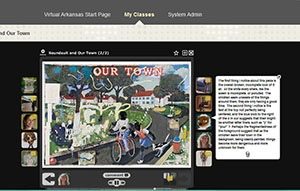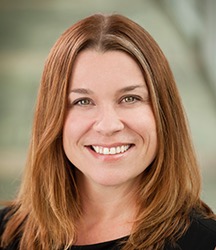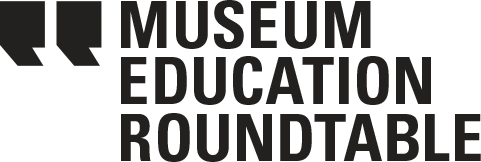Going the Distance
Every once in a while, something happens to make me realize that change can happen. In this case, the change is both technological and pedagogical. Thinking back to 20 plus years ago, I remember talking to the tech team at the San Francisco Museum of Modern Art to see if we could create an online curriculum interface that allowed for student conversations around a work of art. “Nice idea,” they told me, but one that was just not possible given the digital tools available at the time. I’d have to wait. But I don’t have to wait anymore.
This month I spoke with Anne Kryabill, the Guest Editor of the JME’s Distance Learning Issue, (Vol. 40 No. 3). Anne is the Director of Education and Research in Learning at Crystal Bridges Museum of American Art, and she told me how Crystal Bridges uses a tool called VoiceThread within their distance-learning module for high school students. This tool has great features that enable many students to simultaneously make comments about a work of art that sits visually at the center of the online conversation. VoiceThread lets participants visually highlight a portion of the work to direct their peers to something specific; insert recorded video or voice comments; and, if necessary, even call a phone number to record their ideas for posting. Within these online conversations, students can see what the others are saying and if they want, react to those statements over time. The exchange is far more expansive than it would be during a time-bound gallery visit.
 Yet, the real pedagogical kicker for me was when Anne said that the conversation around the artwork itself becomes a record that can be studied. If permissions are properly granted, the conversation can be used to understand student thinking about the art. The educator in me is delighted about the research potential of analyzing those conversations in order to improve teaching. Not only can art talk happen online, but we can also study it and consider how to make those chats become even more worthwhile. Digital tools have evolved further than I could have imagined long ago.
Yet, the real pedagogical kicker for me was when Anne said that the conversation around the artwork itself becomes a record that can be studied. If permissions are properly granted, the conversation can be used to understand student thinking about the art. The educator in me is delighted about the research potential of analyzing those conversations in order to improve teaching. Not only can art talk happen online, but we can also study it and consider how to make those chats become even more worthwhile. Digital tools have evolved further than I could have imagined long ago.
As guest editor of the JME Distance Learning Issue, Anne Kraybill reveals that online learning is finally coming of age. The selected case studies she chose demonstrate how digital technology has matured enough so that museum educators can easily dive into online learning. The variety of digital tools currently available means that we can deliver meaningful experiences with museum content to audiences who may not otherwise have easy access to our physical sites. And, we can obtain the skills necessary to create distance learning through collaborating with others who are experienced with distance education systems. Both K-12 and Higher Education partners can offer extensive know-how with technological production and delivery. Anne indicated that both of these educational systems are further ahead than most museums in their understanding of how to use this technology.
One of the roles of a guest editor for the JME is to bring expertise to the featured topic. Anne offers much with her degrees in Museum Education and Instructional Technology, and her direct experience when she was the Distance Learning manager at Crystal Bridges. In addition, Crystal Bridges held a Distance Learning Summit in 2013 that gathered voices from art museums, Higher Education and the K-12 world to talk about the state of online learning. This event marked a nationwide moment for museums and distance learning, and expanded Anne’s knowledge base even further.
For the JME issue, Anne solicited case studies from Museum Educators working within all types and sizes of museums. As she chose them, she considered the baseline forms of distance learning practice that would demonstrate synchronous, asynchronous, and blended programming. Anne defines and explains these below:
“Many museums have engaged in distance learning through synchronous technologies like video conferencing, where people onsite see and talk with others in real time. I felt it was really important to look at how museums were transforming such traditional onsite approaches into teaching for an online environment.
In this volume museums describe their experiments with synchronous approaches, but transform the scale to one that could rarely be accomplished in person. Others show how they are pushing asynchronous approaches that allow for anytime/anywhere learning, but still allow for personal meaning making. Finally, other museums describe using online learning to engage in conversations before and after traditional onsite visits, employing a blended approach of synchronous, asynchronous, onsite, and offsite programs.
No matter what the approach or the scale of the program, what all of these initiatives have in common is a clear statement about the purpose of the program and the instructional problem the program aims to address.”
I asked Anne to offer some essential advice for those who think some of these practices might work for them and she stressed that distance learning projects be aligned with the museum’s educational purposes. For instance, at Crystal Bridges, changes in statewide educational policy, including mandatory online requirements for high school graduation, were combined with the institution’s interest in reaching students who cannot easily get to the museum site.
Once your museum team has clear goals and outcomes in place, the next step is to determine the core technology that will structure the online experience. In most instances you will chose a learning management system. Since the system you choose will influence your digital tool options, it is extremely important to know what you want to do before you make your choice. Crystal Bridges works with Blackboard. The Museum of Modern Art in New York used the Coursera infrastructure for their Massively Open Online Course (MOOC) that reached thousands of participants. EdCom has been using Google hangout platforms to conduct their Virtual Book Clubs (VBC) for museum educator professional development.
 You can experience an online learning platform, if you haven’t already, during the VBC on distance learning on September 24 at 2 p.m. ET. During that event I will moderate a discussion between Anne and JME article author Naomi Coquillon, Manager of Youth and Teacher Programs at the Smithsonian National Museum of American History. In the JME issue, Naomi writes about the National Youth Summit webcasting series. Her most recent project is a Fall 2015 course through Smithsonian X where she will leverage rich museum content by teaching historical inquiry with objects.
You can experience an online learning platform, if you haven’t already, during the VBC on distance learning on September 24 at 2 p.m. ET. During that event I will moderate a discussion between Anne and JME article author Naomi Coquillon, Manager of Youth and Teacher Programs at the Smithsonian National Museum of American History. In the JME issue, Naomi writes about the National Youth Summit webcasting series. Her most recent project is a Fall 2015 course through Smithsonian X where she will leverage rich museum content by teaching historical inquiry with objects.
The notion of leveraging rich content once again takes me back 20 years. Even though the SFMOMA team I worked with didn’t have today’s tools, we did achieve some breakthroughs in using multimedia to let visitors hear artists tell their own stories and make content come alive in new ways. In spite of what at the time felt like endless hurdles, we understood that we were up to something with great potential as we digitized and sorted through tech glitches that seem so simple when those tasks are done today. You may not realize that videos were nearly impossible to show during early stages of the Internet since the video file sizes were too huge for dial-up modems to process. Back then the solution was to distribute CDs. Remember them?
Anne Kraybill believes that we are again on the cusp of breakthrough moments with distance learning practices and digital teaching methods as more and more robust technological infrastructure is built for instructional delivery. There will be new hurdles to overcome, of course, but the end result could mean that we can offer new kinds of engagement to so many more than before.
To get up to speed yourself, be sure to read the Distance Learning JME issue. If you download the reader guide accompanying this issue, you will get the article, Developing a Model for Technology Based Museum Partnerships by Erika Sanger, Stan Silverman, and Anne Kraybill. The reader guide asks questions that will help you and your educational partners think through collaboration and digital technology practices. If inspired, please post in the comments about your staff conversations using the reader guide or other thoughts on distance learning.
Susan Spero, Ph.D. teaches Museum Studies at the John F. Kennedy University in Berkeley, CA and serves on the Board of the Museum Education Roundtable.

